refuelling PEUGEOT EXPERT 2023 Owners Manual
[x] Cancel search | Manufacturer: PEUGEOT, Model Year: 2023, Model line: EXPERT, Model: PEUGEOT EXPERT 2023Pages: 348, PDF Size: 12 MB
Page 5 of 348
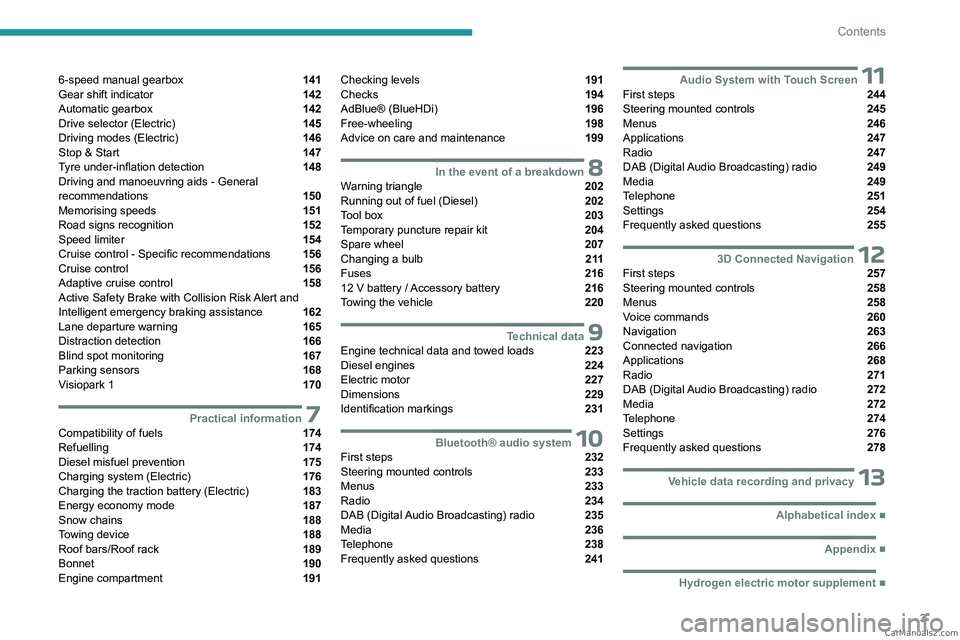
3
Contents
6-speed manual gearbox 141
Gear shift indicator 142
Automatic gearbox 142
Drive selector (Electric) 145
Driving modes (Electric) 146
Stop & Start 147
Tyre under-inflation detection 148
Driving and manoeuvring aids - General
recommendations
150
Memorising speeds 151
Road signs recognition 152
Speed limiter 154
Cruise control - Specific recommendations 156
Cruise control 156
Adaptive cruise control 158
Active Safety Brake with Collision Risk Alert and
Intelligent emergency braking assistance
162
Lane departure warning 165
Distraction detection 166
Blind spot monitoring 167
Parking sensors 168
Visiopark 1 170
7Practical informationCompatibility of fuels 174
Refuelling 174
Diesel misfuel prevention 175
Charging system (Electric) 176
Charging the traction battery (Electric) 183
Energy economy mode 187
Snow chains 188
Towing device 188
Roof bars/Roof rack 189
Bonnet 190
Engine compartment 191
Checking levels 191
Checks 194
AdBlue® (BlueHDi) 196
Free-wheeling 198
Advice on care and maintenance 199
8In the event of a breakdownWarning triangle 202
Running out of fuel (Diesel) 202
Tool box 203
Temporary puncture repair kit 204
Spare wheel 207
Changing a bulb 2 11
Fuses 216
12
V battery
/ Accessory battery 216
Towing the vehicle 220
9Technical dataEngine technical data and towed loads 223
Diesel engines 224
Electric motor 227
Dimensions 229
Identification markings 231
10Bluetooth® audio systemFirst steps 232
Steering mounted controls 233
Menus 233
Radio 234
DAB (Digital Audio Broadcasting) radio 235
Media 236
Telephone 238
Frequently asked questions 241
11Audio System with Touch ScreenFirst steps 244
Steering mounted controls 245
Menus 246
Applications 247
Radio 247
DAB (Digital Audio Broadcasting) radio 249
Media 249
Telephone 251
Settings 254
Frequently asked questions 255
123D Connected NavigationFirst steps 257
Steering mounted controls 258
Menus 258
Voice commands 260
Navigation 263
Connected navigation 266
Applications 268
Radio 271
DAB (Digital Audio Broadcasting) radio 272
Media 272
Telephone 274
Settings 276
Frequently asked questions 278
13Vehicle data recording and privacy
■
Alphabetical index
■
Appendix
■
Hydrogen electric motor supplement CarM an uals 2 .c o m
Page 87 of 348
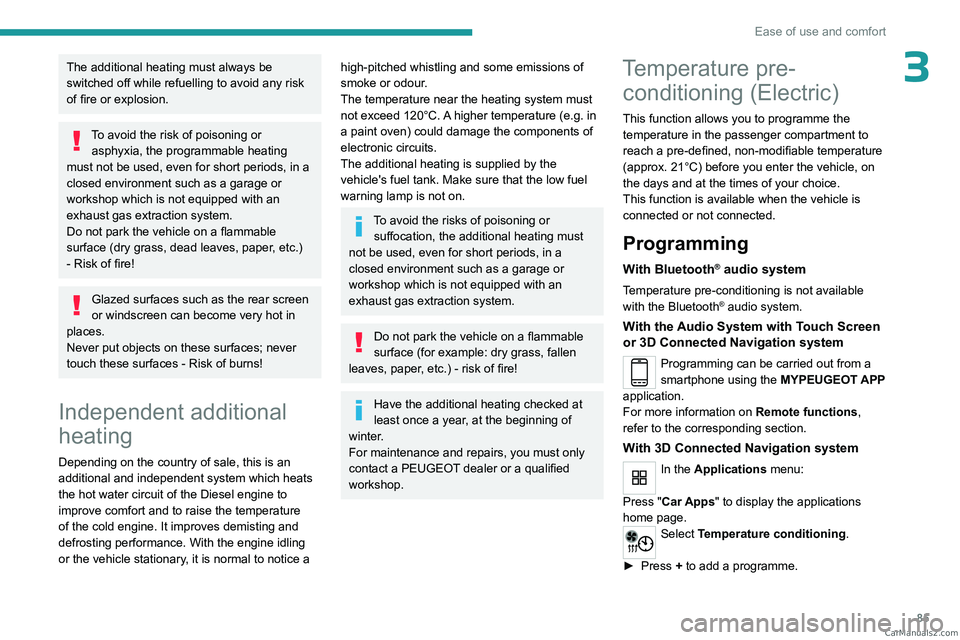
85
Ease of use and comfort
3The additional heating must always be
switched off while refuelling to avoid any risk
of fire or explosion.
To avoid the risk of poisoning or asphyxia, the programmable heating
must not be used, even for short periods, in a
closed environment such as a garage or
workshop which is not equipped with an
exhaust gas extraction system.
Do not park the vehicle on a flammable
surface (dry grass, dead leaves, paper, etc.)
- Risk of fire!
Glazed surfaces such as the rear screen
or windscreen can become very hot in
places.
Never put objects on these surfaces; never
touch these surfaces - Risk of burns!
Independent additional
heating
Depending on the country of sale, this is an
additional and independent system which heats
the hot water circuit of the Diesel engine to
improve comfort and to raise the temperature
of the cold engine. It improves demisting and
defrosting performance. With the engine idling
or the vehicle stationary, it is normal to notice a
high-pitched whistling and some emissions of
smoke or odour.
The temperature near the heating system must
not exceed 120°C. A higher temperature (e.g. in
a paint oven) could damage the components of
electronic circuits.
The additional heating is supplied by the
vehicle's fuel tank. Make sure that the low fuel
warning lamp is not on.
To avoid the risks of poisoning or suffocation, the additional heating must
not be used, even for short periods, in a
closed environment such as a garage or
workshop which is not equipped with an
exhaust gas extraction system.
Do not park the vehicle on a flammable
surface (for example: dry grass, fallen
leaves, paper, etc.) - risk of fire!
Have the additional heating checked at
least once a year, at the beginning of
winter.
For maintenance and repairs, you must only
contact a PEUGEOT dealer or a qualified
workshop.
Temperature pre- conditioning (Electric)
This function allows you to programme the
temperature in the passenger compartment to
reach a pre-defined, non-modifiable temperature
(approx. 21°C) before you enter the vehicle, on
the days and at the times of your choice.
This function is available when the vehicle is
connected or not connected.
Programming
With Bluetooth® audio system
Temperature pre-conditioning is not available
with the Bluetooth® audio system.
With the Audio System with T ouch Screen
or 3D Connected Navigation system
Programming can be carried out from a
smartphone using the MYPEUGEOT APP
application.
For more information on Remote functions,
refer to the corresponding section.
With 3D Connected Navigation system
In the Applications menu:
Press " Car Apps" to display the applications
home page.
Select Temperature conditioning .
►
Press
+ to add a programme. CarM an uals 2 .c o m
Page 176 of 348
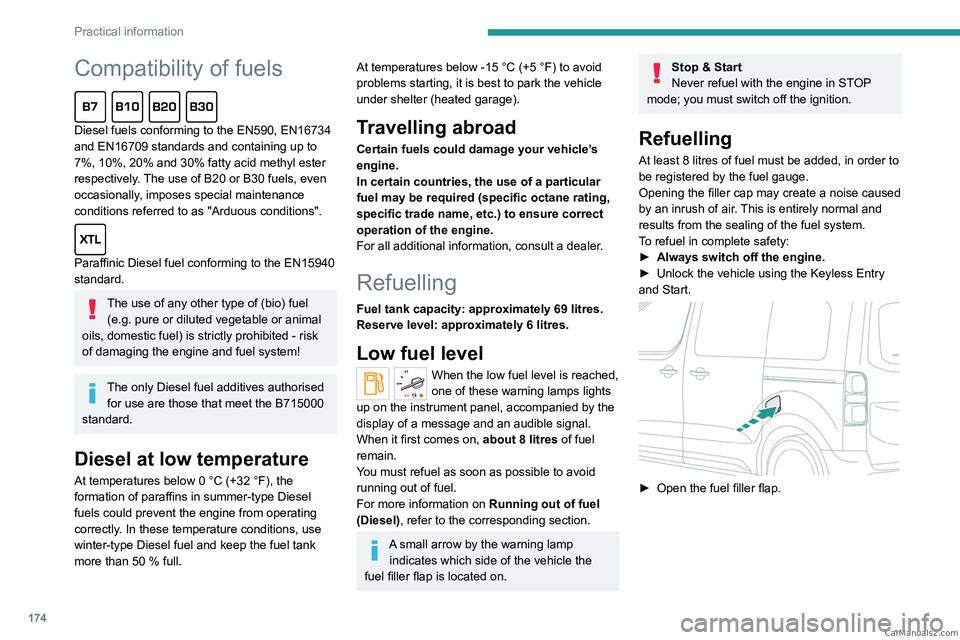
174
Practical information
Compatibility of fuels
Diesel fuels conforming to the EN590, EN16734
and EN16709 standards and containing up to
7%, 10%, 20% and 30% fatty acid methyl ester
respectively. The use of B20 or B30 fuels, even
occasionally, imposes special maintenance
conditions referred to as "Arduous conditions".
Paraffinic Diesel fuel conforming to the EN15940
standard.
The use of any other type of (bio) fuel (e.g. pure or diluted vegetable or animal
oils, domestic fuel) is strictly prohibited - risk
of damaging the engine and fuel system!
The only Diesel fuel additives authorised for use are those that meet the B715000
standard.
Diesel at low temperature
At temperatures below 0 °C (+32 °F), the
formation of paraffins in summer-type Diesel
fuels could prevent the engine from operating
correctly
. In these temperature conditions, use
winter-type Diesel fuel and keep the fuel tank
more than 50
% full.
At temperatures below -15 °C (+5 °F) to avoid
problems starting, it is best to park the vehicle
under shelter (heated garage).
Travelling abroad
Certain fuels could damage your vehicle’s
engine.
In certain countries, the use of a particular
fuel may be required (specific octane rating,
specific trade name, etc.) to ensure correct
operation of the engine.
For all additional information, consult a dealer.
Refuelling
Fuel tank capacity: approximately 69 litres.
Reserve level: approximately 6 litres.
Low fuel level
When the low fuel level is reached,
one of these warning lamps lights
up on the instrument panel, accompanied by the
display of a message and an audible signal.
When it first comes on, about 8 litres of fuel
remain.
You must refuel as soon as possible to avoid
running out of fuel.
For more information on Running out of fuel
(Diesel), refer to the corresponding section.
A small arrow by the warning lamp indicates which side of the vehicle the
fuel filler flap is located on.
Stop & Start
Never refuel with the engine in STOP
mode; you must switch off the ignition.
Refuelling
At least 8 litres of fuel must be added, in order to
be registered by the fuel gauge.
Opening the filler cap may create a noise caused
by an inrush of air. This is entirely normal and
results from the sealing of the fuel system.
To refuel in complete safety:
►
Always switch off the engine.
►
Unlock the vehicle using the Keyless Entry
and Start.
► Open the fuel filler flap. CarM an uals 2 .c o m
Page 178 of 348
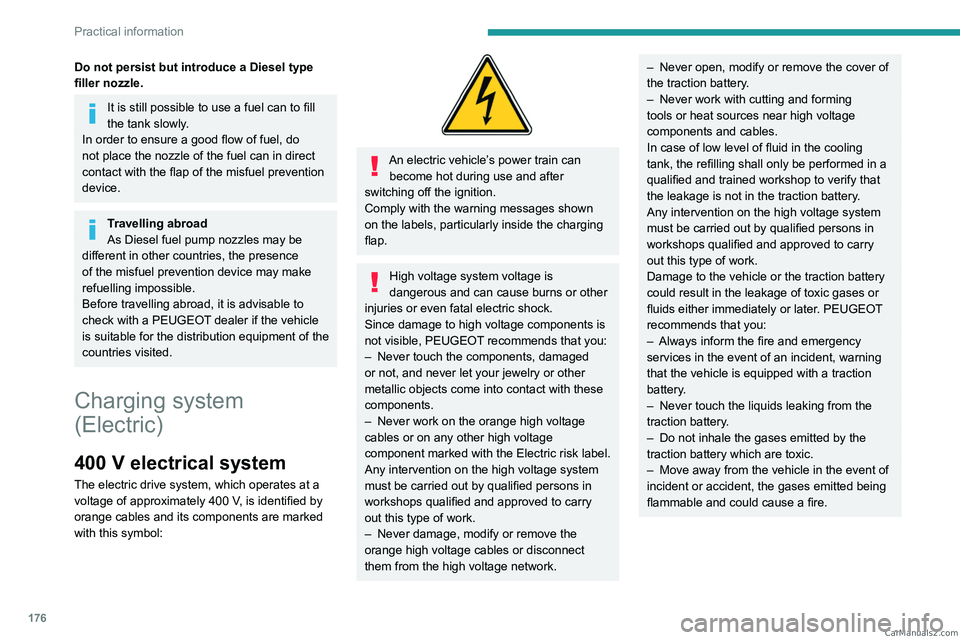
176
Practical information
Do not persist but introduce a Diesel type
filler nozzle.
It is still possible to use a fuel can to fill
the tank slowly.
In order to ensure a good flow of fuel, do
not place the nozzle of the fuel can in direct
contact with the flap of the misfuel prevention
device.
Travelling abroad
As Diesel fuel pump nozzles may be
different in other countries, the presence
of the misfuel prevention device may make
refuelling impossible.
Before travelling abroad, it is advisable to
check with a PEUGEOT dealer if the vehicle
is suitable for the distribution equipment of the
countries visited.
Charging system
(Electric)
400 V electrical system
The electric drive system, which operates at a
voltage of approximately 400 V, is identified by
orange cables and its components are marked
with this symbol:
An electric vehicle’s power train can become hot during use and after
switching off the ignition.
Comply with the warning messages shown
on the labels, particularly inside the charging
flap.
High voltage system voltage is
dangerous and can cause burns or other
injuries or even fatal electric shock.
Since damage to high voltage components is
not visible, PEUGEOT recommends that you:
–
Never touch the components, damaged
or not, and never let your jewelry or other
metallic objects come into contact with these
components.
–
Never work on the orange high voltage
cables or on any other high voltage
component marked with the Electric risk label.
Any intervention on the high voltage system
must be carried out by qualified persons in
workshops qualified and approved to carry
out this type of work.
–
Never damage, modify or remove the
orange high voltage cables or disconnect
them from the high voltage network.
– Never open, modify or remove the cover of
the traction battery .
–
Never work with cutting and forming
tools or heat sources near high voltage
components and cables.
In case of low level of fluid in the cooling
tank, the refilling shall only be performed in a
qualified and trained workshop to verify that
the leakage is not in the traction battery
.
Any intervention on the high voltage system
must be carried out by qualified persons in
workshops qualified and approved to carry
out this type of work.
Damage to the vehicle or the traction battery
could result in the leakage of toxic gases or
fluids either immediately or later. PEUGEOT
recommends that you:
–
Always inform the fire and emergency
services in the event of an incident, warning
that the vehicle is equipped with a traction
battery
.
–
Never touch the liquids leaking from the
traction battery
.
–
Do not inhale the gases emitted by the
traction battery which are toxic.
–
Move away from the vehicle in the event of
incident or accident, the gases emitted being
flammable and could cause a fire.
CarM an uals 2 .c o m
Page 204 of 348
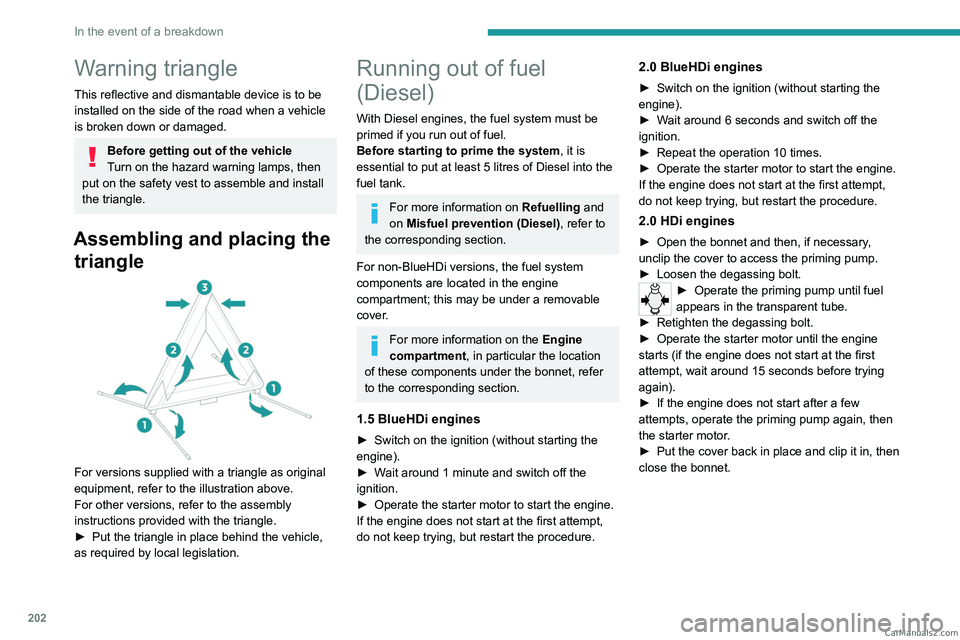
202
In the event of a breakdown
Warning triangle
This reflective and dismantable device is to be
installed on the side of the road when a vehicle
is broken down or damaged.
Before getting out of the vehicle
Turn on the hazard warning lamps, then
put on the safety vest to assemble and install
the triangle.
Assembling and placing the triangle
For versions supplied with a triangle as original
equipment, refer to the illustration above.
For other versions, refer to the assembly
instructions provided with the triangle.
►
Put the triangle in place behind the vehicle,
as required by local legislation.
Running out of fuel
(Diesel)
With Diesel engines, the fuel system must be
primed if you run out of fuel.
Before starting to prime the system, it is
essential to put at least 5 litres of Diesel into the
fuel tank.
For more information on Refuelling and
on Misfuel prevention (Diesel), refer to
the corresponding section.
For non-BlueHDi versions, the fuel system
components are located in the engine
compartment; this may be under a removable
cover.
For more information on the Engine
compartment, in particular the location
of these components under the bonnet, refer
to the corresponding section.
1.5 BlueHDi engines
► Switch on the ignition (without starting the
engine).
►
W
ait around 1 minute and switch off the
ignition.
►
Operate the starter motor to start the engine.
If the engine does not start at the first attempt,
do not keep trying, but restart the procedure.
2.0 BlueHDi engines
► Switch on the ignition (without starting the
engine).
►
W
ait around 6 seconds and switch off the
ignition.
►
Repeat the operation 10
times.
►
Operate the starter motor to start the engine.
If the engine does not start at the first attempt,
do not keep trying, but restart the procedure.
2.0 HDi engines
► Open the bonnet and then, if necessary ,
unclip the cover to access the priming pump.
►
Loosen the degassing bolt.
► Operate the priming pump until fuel
appears in the transparent tube.
►
Retighten the degassing bolt.
►
Operate the starter motor until the engine
starts (if the engine does not start at the first
attempt, wait around 15
seconds before trying
again).
►
If the engine does not start after a few
attempts, operate the priming pump again, then
the starter motor
.
►
Put the cover back in place and clip it in, then
close the bonnet. CarM an uals 2 .c o m
Page 303 of 348
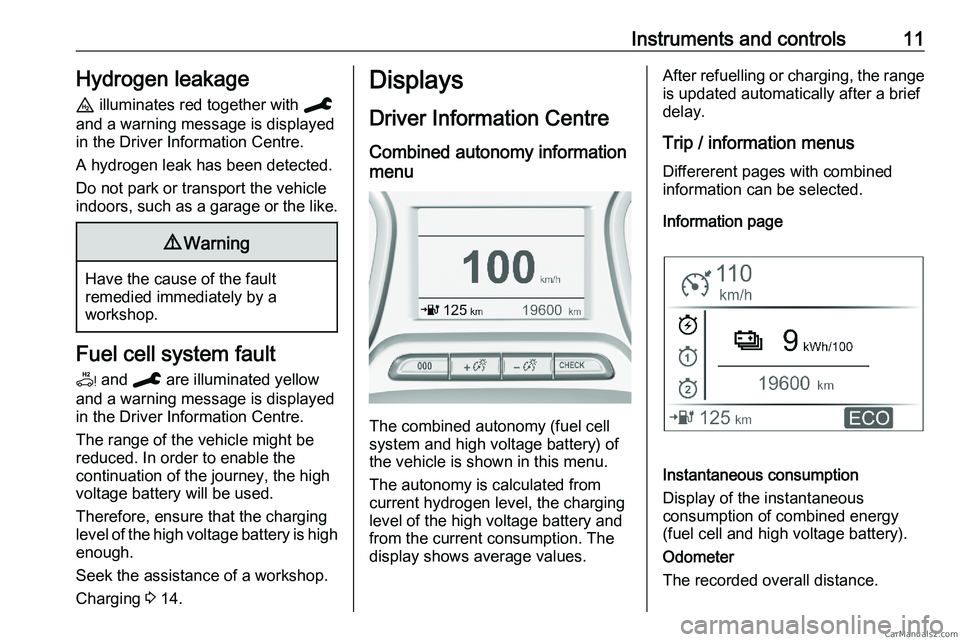
Instruments and controls 11
Hydrogen leakage
u illuminates red together with C
and a warning message is displayed
in the Driver Information Centre.
A hydrogen leak has been detected.
Do not park or transport the vehicle
indoors,
such as a garage or the like. 9
Warning Have the cause of the fault
remedied immediately by a
workshop. Fuel cell system fault
v and C are illuminated yellow
and a warning message is displayed
in the Driver Information Centre.
The range of the vehicle might be
reduced. In order to enable the
continuation of the journey, the high
voltage battery will be used.
Therefore, ensure that the charging
level
of the high voltage battery is high
enough.
Seek the assistance of a workshop.
Charging 3 14. Displays
Driver Information Centre Combined autonomy information
menu The combined autonomy (fuel cell
system and high voltage battery) of
the vehicle is shown in this menu.
The autonomy is calculated from
current hydrogen level, the charging
level of the high voltage battery and
from the current consumption. The
display shows average values. After refuelling or charging, the range
is updated automatically after a brief
delay.
Trip / information menus
Differerent pages with combined
information can be selected.
Information page Instantaneous consumption
Display of the instantaneous
consumption of combined energy
(fuel cell and high voltage battery).
Odometer
The recorded overall distance.CarM an uals 2 .c o m
Page 305 of 348
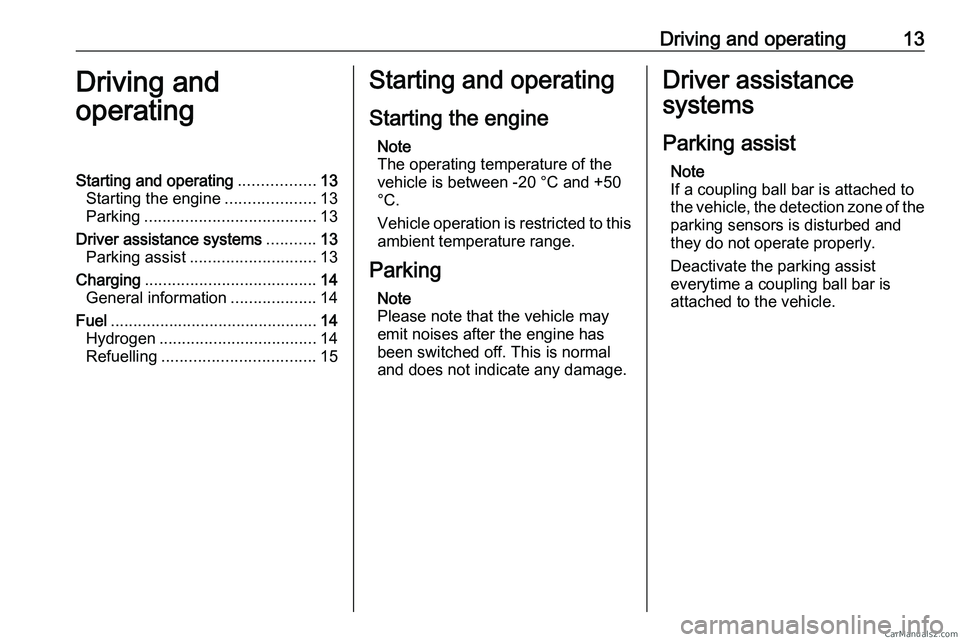
Driving and operating 13
Driving and
operating
Starting and operating .................13
Starting the engine ....................13
Parking ...................................... 13
Driver assistance systems ...........13
Parking assist ............................ 13
Charging ...................................... 14
General information ...................14
Fuel .............................................. 14
Hydrogen ................................... 14
Refuelling .................................. 15 Starting and operating
Starting the engine Note
The operating temperature of the
vehicle is between -20 °C and +50
°C.
Vehicle
operation is restricted to this
ambient temperature range.
Parking Note
Please note that the vehicle may
emit noises after the engine has
been switched off. This is normal
and does not indicate any damage. Driver assistance
systems
Parking assist Note
If a coupling ball bar is attached to
the
vehicle, the detection zone of the
parking sensors is disturbed and
they do not operate properly.
Deactivate the parking assist
everytime a coupling ball bar is
attached to the vehicle.CarM an uals 2 .c o m
Page 306 of 348
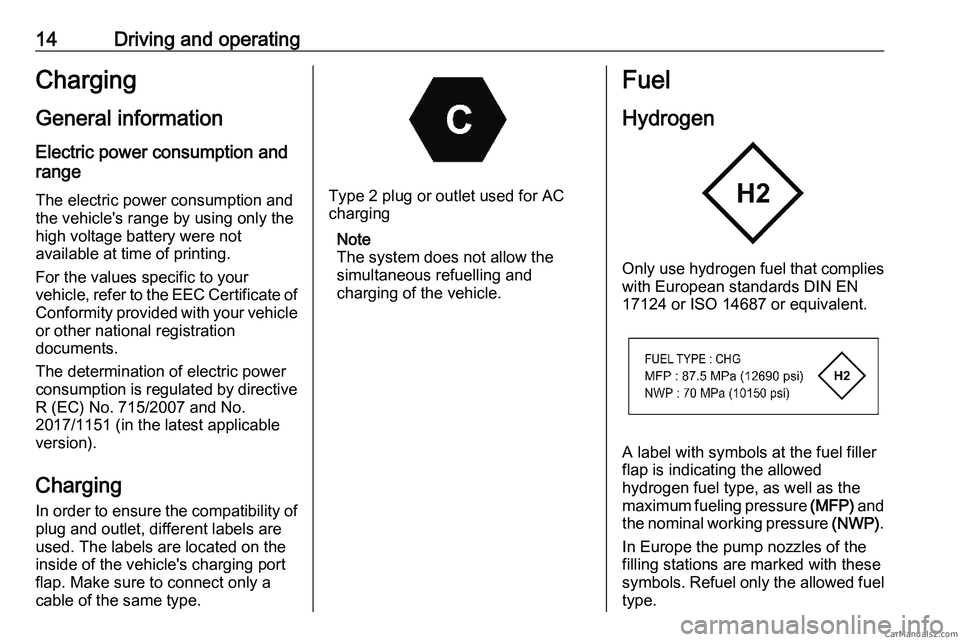
14 Driving and operating
Charging
General information Electric power consumption and
rangeThe electric power consumption and
the vehicle's range by using only the
high voltage battery were not
available at time of printing.
For the values specific to your
vehicle,
refer to the EEC Certificate of
Conformity provided with your vehicle
or other national registration
documents.
The determination of electric power
consumption is regulated by directive
R (EC) No. 715/2007 and No.
2017/1151 (in the latest applicable
version).
Charging
In order to ensure the compatibility of
plug and outlet, different labels are
used. The labels are located on the
inside of the vehicle's charging port
flap. Make sure to connect only a
cable of the same type. Type 2 plug or outlet used for AC
charging
Note
The system does not allow the
simultaneous refuelling and
charging of the vehicle. Fuel
Hydrogen Only use hydrogen fuel that complies
with European standards DIN EN
17124 or ISO 14687 or equivalent. A label with symbols at the fuel filler
flap is indicating the allowed
hydrogen fuel type, as well as the
maximum
fueling pressure (MFP) and
the nominal working pressure (NWP).
In Europe the pump nozzles of the
filling stations are marked with these
symbols. Refuel only the allowed fuel type.CarM an uals 2 .c o m
Page 307 of 348
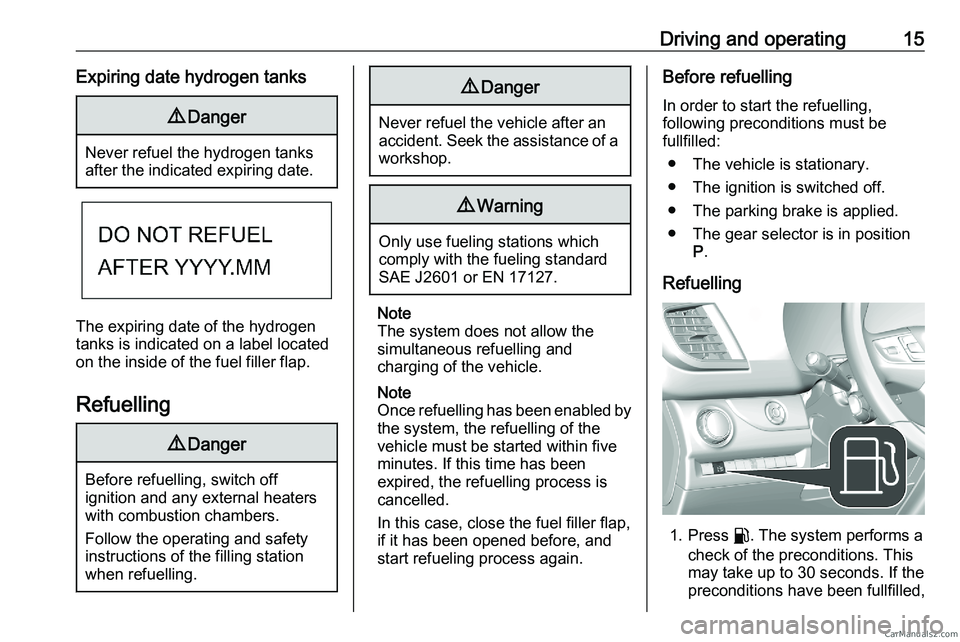
Driving and operating 15
Expiring date hydrogen tanks 9
Danger Never refuel the hydrogen tanks
after the indicated expiring date.
The expiring date of the hydrogen
tanks is indicated on a label located
on the inside of the fuel filler flap.
Refuelling 9
Danger Before refuelling, switch off
ignition and any external heaters
with combustion chambers.
Follow the operating and safety
instructions of the filling station
when refuelling. 9
Danger Never refuel the vehicle after an
accident.
Seek the assistance of a
workshop. 9
Warning Only use fueling stations which
comply with the fueling standard
SAE J2601 or EN 17127.
Note
The system does not allow the
simultaneous refuelling and
charging of the vehicle.
Note
Once
refuelling has been enabled by
the system, the refuelling of the
vehicle must be started within five
minutes. If this time has been
expired, the refuelling process is
cancelled.
In this case, close the fuel filler flap,
if it has been opened before, and
start refueling process again. Before refuelling
In order to start the refuelling,
following preconditions must be
fullfilled:
●
The vehicle is stationary.
● The ignition is switched off.
● The parking brake is applied.
● The gear selector is in position P.
Refuelling 1. Press r. The system performs a
check of the preconditions. This
may take up to 30 seconds. If the
preconditions have been fullfilled,CarM an uals 2 .c o m
Page 308 of 348
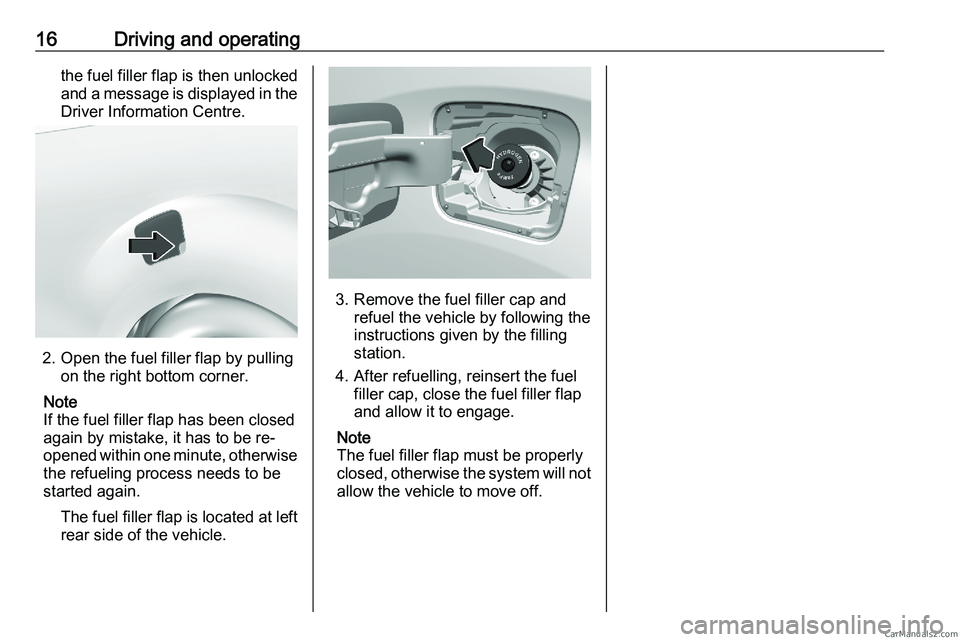
16 Driving and operating
the fuel filler flap is then unlocked
and a message is displayed in the
Driver Information Centre. 2. Open the fuel filler flap by pulling
on the right bottom corner.
Note
If the fuel filler flap has been closed
again by mistake, it has to be re-
opened
within one minute, otherwise
the refueling process needs to be
started again.
The fuel filler flap is located at leftrear side of the vehicle. 3. Remove the fuel filler cap and
refuel the vehicle by following the
instructions given by the filling
station.
4.
After refuelling, reinsert the fuel
filler cap, close the fuel filler flap
and allow it to engage.
Note
The fuel filler flap must be properly
closed, otherwise the system will not allow the vehicle to move off.CarM an uals 2 .c o m